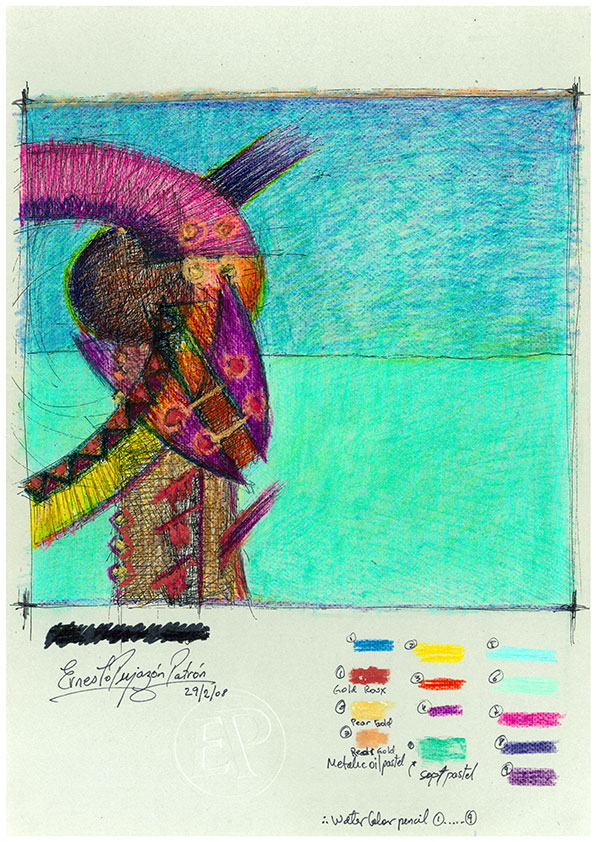Development and thought about the making Ernesto Carlos Pujazon Patron. The act of drawing is a pure reflection of my psyche and identity. It evolved within the aspect of my character — idiosyncrasies, faith, belief, and experiences. However, this body of work does not tend to fall definitely into any particular category of drawing. The work/drawings here were intended mostly to replicate or simplify the thinking process visually throughout a series of marks and scribbles onto a surface.
These works/drawings were arranged tentatively from mere scribbles to more conceptual ones whose material representation involve water, air, sand, a solitude landscape, the sun, moon, and totems. Some drawings represent striking a lonely path defuse in the mist of the landscape using graphite pencil until the fragile medium begins to fade or disappear in the lyrics of softness that form engaging issues of time, space and memories.
Unconsciously the image depicted was a circle; it more or less occupied the whole format chosen, using the bottom center of the paper, followed by other random conscious lines to differentiate spaces within the fore, middle, and background. The sketches started to take some sort of form with a clear definition of spaces. Sometimes I allowed myself to continue working on a drawing, sometimes the sketch itself did not speak to me.
Each sketch was the beginning to a new series of unforeseen possibilities to develop or to bring to life an imaginary idea. For me, drawing is a reflected act of curiosity that inspires my mental processes to emerge with something that no one has seen before. Drawing gives form to my visual thoughts. This process of making marks represents something on a surface that can be taken to the next step with a color application using conventional materials such as colored pencil, watercolors, inks of simple oils, or pastel metallic colors.
There is no wrong doing, only moments when a stroke, mark, or trace is important to the others; with color, the impact of one might be more outstanding than others. The dynamic of arranging the composition allows the exploration of a number of possibilities — to modify, alter or mutate with uncertain feeling. In direct contrast with the notion of composition is my desire for compositional pleasure that requires a balance between emotion, intuition, instinct and reason.
The purpose is not to represent something in a manner that relies on realistic representation but rather a means to discovering relationships between dimension, space, shape, scale and proportion and the desire to create aesthetic pleasure. These drawings gather visual data and specific geometrical shapes, or soft data i.e. experiences, activities and feelings that test the boundaries of the format to allow me to push conventional means from an abstract level to a more materialized idea or thought.
This visual thought navigates in my mind freely without obstacles waiting to be explored. Compositions intuitively balance spaces in a coercive way and transcend physical dimension … execution at the moment of creation becomes visible.
In the interaction of figure/ground, some areas move to the foreground to make the visual representation more outstanding. Collecting data to be added to the visual representation may apprehend it. Conventional graphic depiction helps overrule the drawing where adjusting and shifting alter the viewpoint or frame. What is important are the marks made onto the surface of the paper; what develops thereafter will remain important as well. What my eyes capture show in some way my unseeing cultural reference, sensitiveness, and personal experiences. Some drawings depicted here grasp the continuity of time.

Throughout the development of the works/drawings, turning points or the ideas of making become distracted. These accidents benefit the work through a dualistic relationship between making a mark and revealing ideas or intentions. Through drawing, I reveal the unseen by using graphite or a B-pencil that allows me to understand the advances and limitations of the medium. Catherine Dee said, “Different processes and media engage different aspects of the environment and the realm of potential ideas. They invite certain uses, certain means, certain preoccupations—all informed by a collective cultural history. For this reason, we require either a critical approach to any medium or alternatively one that almost ignores the chosen means, but the one that is always concerned with the quality of an idea and not its visual characteristics.” Drawing/Thinking; Confronting An Electronic Age; Edited by Marc Treib; 2008, Routledge, Taylor & Francis Group. London and New York.

